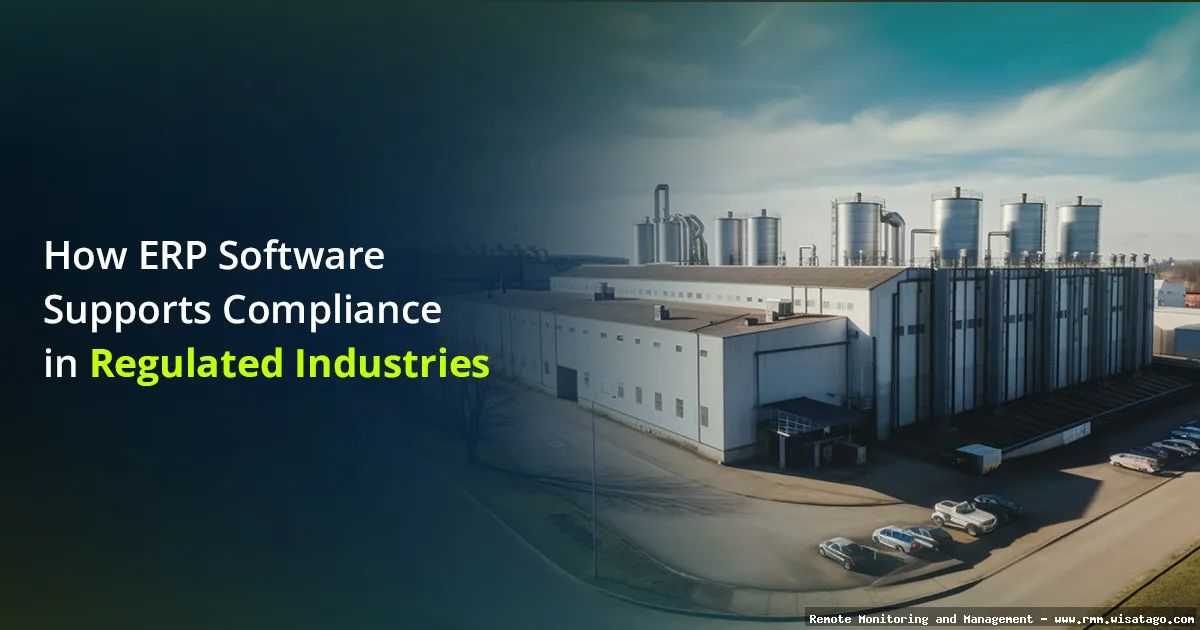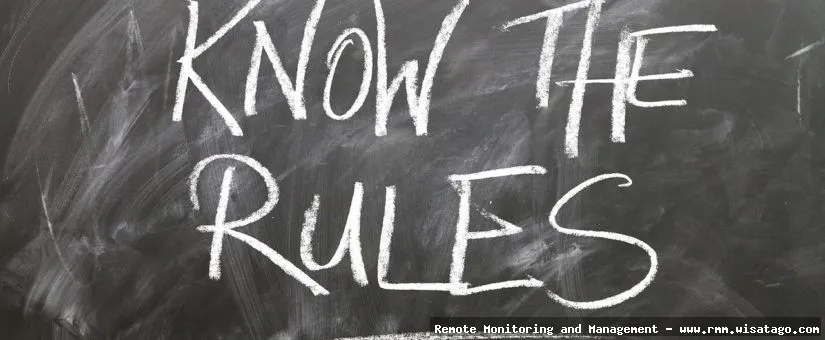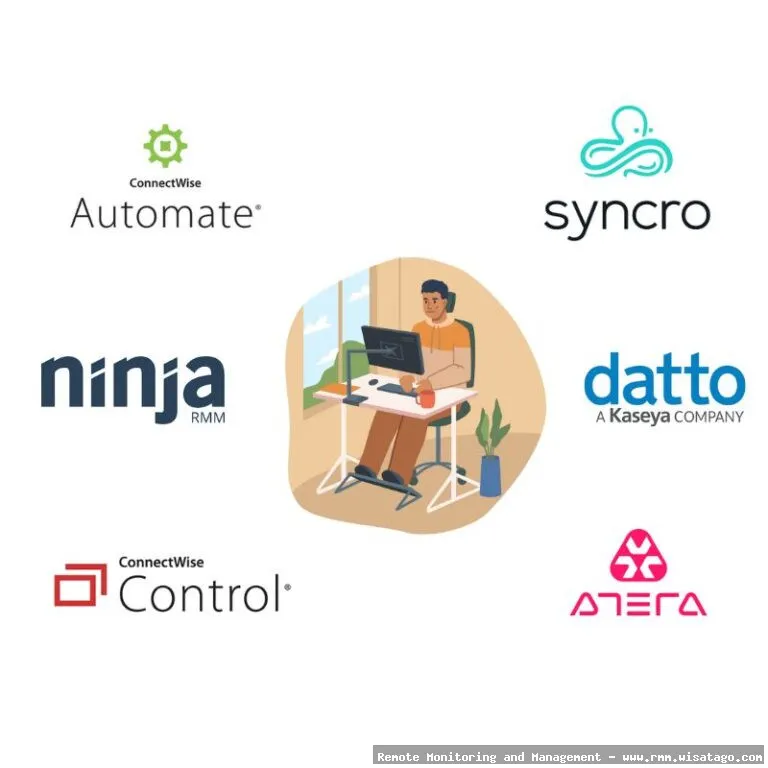Navigating the complex landscape of regulated industries can feel like walking a tightrope. From healthcare and finance to manufacturing and government, organizations face a constant barrage of compliance requirements. Failing to meet these standards can result in hefty fines, reputational damage, and even legal repercussions. In this environment, IT teams are under immense pressure to ensure that their systems and processes are not only efficient and secure but also fully compliant with all applicable regulations.
Remote Monitoring and Management (RMM) solutions have emerged as invaluable tools for IT professionals, offering a centralized platform to monitor, manage, and secure endpoints remotely. However, the real power of RMM in regulated industries lies in its ability to generate comprehensive compliance reports. These reports provide documented evidence that an organization is adhering to specific regulatory requirements, significantly reducing the risk of non-compliance and streamlining the auditing process.

This article delves into the critical role of RMM compliance reporting in regulated industries. We’ll explore the specific features and functionalities that make RMM solutions essential for maintaining compliance, the challenges IT teams face, and best practices for leveraging RMM to achieve and demonstrate adherence to industry-specific regulations. Whether you’re a seasoned IT veteran or new to the world of RMM, this guide will provide a complete overview of how to effectively utilize RMM for compliance reporting and build a robust compliance posture.
Understanding RMM and Its Role in Compliance
Remote Monitoring and Management (RMM) software provides IT professionals with the ability to remotely monitor, manage, and support client endpoints, including servers, desktops, laptops, and mobile devices. It acts as a centralized hub, allowing IT teams to proactively identify and resolve issues before they escalate, maintain system security, and automate routine tasks. In the context of regulated industries, RMM plays a crucial role in ensuring that IT infrastructure adheres to specific compliance standards.
Key RMM Features for Compliance
Several key RMM features directly contribute to compliance efforts:

- Asset Discovery and Inventory: RMM solutions automatically discover and catalog all hardware and software assets on the network. This provides a comprehensive inventory, essential for tracking and managing assets in compliance with regulations like HIPAA (Health Insurance Portability and Accountability Act) or PCI DSS (Payment Card Industry Data Security Standard).
- Patch Management: Keeping systems up-to-date with the latest security patches is critical for preventing vulnerabilities and maintaining compliance. RMM automates the patch management process, ensuring that all endpoints are promptly updated with the latest security fixes.
- Software Deployment and Management: RMM allows for the remote deployment and management of software applications. This ensures that all endpoints are running approved and compliant software versions, as required by many regulations.
- Security Monitoring and Alerting: RMM continuously monitors systems for security threats and suspicious activity. Automated alerts notify IT teams of potential breaches or vulnerabilities, enabling them to respond quickly and mitigate risks.
- Remote Access and Control: RMM provides secure remote access to endpoints, allowing IT professionals to troubleshoot issues and perform maintenance tasks without physically being on-site. This is particularly useful for organizations with geographically dispersed locations.
- Reporting and Auditing: RMM generates detailed reports on system performance, security events, and compliance status. These reports provide documented evidence of compliance efforts and are essential for audits.
Compliance Requirements in Regulated Industries
The specific compliance requirements vary depending on the industry and the regulations in place. Understanding these requirements is the first step in leveraging RMM for compliance reporting.
Examples of Industry-Specific Regulations
- Healthcare (HIPAA): HIPAA mandates the protection of patient health information (PHI). RMM can help ensure compliance by securing endpoints, monitoring access to PHI, and generating reports on security incidents.
- Finance (PCI DSS, SOX): PCI DSS requires merchants to protect credit card data. RMM can assist with compliance by ensuring secure network configurations, monitoring for vulnerabilities, and logging access to sensitive data. SOX (Sarbanes-Oxley Act) focuses on financial reporting and internal controls. RMM helps by ensuring data integrity and providing audit trails of system changes.
- Manufacturing (ITAR, CMMC): ITAR (International Traffic in Arms Regulations) governs the export and import of defense-related articles and services. CMMC (Cybersecurity Maturity Model Certification) is a framework for protecting controlled unclassified information (CUI) within the defense industrial base. RMM can help these organizations secure their IT infrastructure, control access to sensitive data, and demonstrate compliance with these regulations.
- Government (FISMA): FISMA (Federal Information Security Management Act) requires federal agencies and their contractors to implement security controls to protect government information and systems. RMM can assist with compliance by providing tools for asset management, vulnerability scanning, and security monitoring.
Key Compliance Areas Addressed by RMM
Regardless of the specific industry, RMM can help address several key compliance areas:
- Data Security: Protecting sensitive data from unauthorized access, use, or disclosure.
- Access Control: Restricting access to systems and data based on user roles and permissions.
- Audit Trails: Maintaining a record of system activity for auditing purposes.
- Incident Response: Having a plan in place to respond to security incidents and data breaches.
- Vulnerability Management: Identifying and mitigating vulnerabilities in systems and applications.
RMM Compliance Reporting: Features and Benefits
The ability to generate comprehensive compliance reports is a cornerstone of using RMM in regulated industries. These reports provide documented evidence of compliance efforts and are essential for audits and assessments.

Essential Reporting Features
- Customizable Reports: RMM should allow you to customize reports to meet the specific requirements of different regulations. This includes selecting the data to be included, defining reporting periods, and formatting the reports to match your organization’s standards.
- Automated Report Generation: Automating report generation saves time and ensures that reports are generated consistently. RMM should allow you to schedule reports to be generated automatically on a regular basis.
- Real-Time Data: Reports should be based on real-time data, providing an accurate snapshot of the current compliance status.
- Detailed Audit Trails: Reports should include detailed audit trails of system activity, including user logins, software installations, and configuration changes.
- Exception Reporting: RMM should highlight any exceptions or deviations from compliance standards, allowing IT teams to quickly identify and address potential issues.
- Secure Storage and Access: Compliance reports often contain sensitive information and should be stored securely with controlled access.
Benefits of RMM Compliance Reporting
- Simplified Audits: Comprehensive compliance reports make audits significantly easier and faster. Auditors can quickly review the reports to verify compliance with specific regulations.
- Reduced Risk of Non-Compliance: Regular compliance reports help identify and address potential compliance gaps before they lead to penalties or fines.
- Improved Security Posture: By monitoring systems for security threats and vulnerabilities, RMM helps improve the overall security posture of the organization.
- Enhanced Efficiency: Automating compliance reporting saves time and resources, allowing IT teams to focus on other critical tasks.
- Demonstrated Compliance: Compliance reports provide documented evidence of compliance efforts, which can be used to demonstrate compliance to customers, partners, and regulators.
Challenges in Implementing RMM for Compliance
While RMM offers significant benefits for compliance, implementing and managing an RMM solution can present several challenges.
Common Challenges
- Complexity: RMM solutions can be complex to configure and manage, especially for organizations with large and distributed IT environments.
- Integration: Integrating RMM with existing IT systems and security tools can be challenging.
- Data Overload: RMM generates a large amount of data, which can be overwhelming to analyze.
- False Positives: Security monitoring tools can generate false positives, requiring IT teams to investigate and resolve issues that are not actually threats.
- Training: IT staff need to be properly trained on how to use and manage the RMM solution effectively.
- Cost: RMM solutions can be expensive, especially for small and medium-sized businesses.
Overcoming the Challenges
To overcome these challenges, organizations should:
- Choose the Right RMM Solution: Select an RMM solution that meets the specific needs of the organization and is easy to use and manage. Consider factors like scalability, integration capabilities, and support.
- Develop a Clear Implementation Plan: Create a detailed implementation plan that outlines the goals of the RMM deployment, the resources required, and the timeline for completion.
- Provide Adequate Training: Ensure that IT staff are properly trained on how to use and manage the RMM solution effectively.
- Automate Tasks: Automate as many tasks as possible, such as patch management, software deployment, and report generation.
- Regularly Review and Refine: Regularly review the RMM configuration and processes to ensure that they are still effective and meeting the needs of the organization.
- Seek Expert Assistance: Consider working with a managed service provider (MSP) or consultant to help with the implementation and management of the RMM solution.
Best Practices for RMM Compliance Reporting
To maximize the effectiveness of RMM for compliance reporting, organizations should follow these best practices:

Essential Best Practices
- Define Clear Compliance Goals: Clearly define the compliance goals and objectives that the RMM solution should help achieve.
- Map RMM Features to Compliance Requirements: Identify which RMM features can be used to address specific compliance requirements.
- Configure RMM Settings Appropriately: Configure the RMM settings to accurately reflect the organization’s compliance policies and procedures.
- Customize Reports to Meet Specific Needs: Customize reports to include the data and information required by specific regulations.
- Automate Report Generation and Distribution: Automate the generation and distribution of compliance reports to ensure that they are generated consistently and delivered to the appropriate stakeholders.
- Review Reports Regularly: Regularly review compliance reports to identify potential issues and take corrective action.
- Document Compliance Efforts: Document all compliance efforts, including RMM configurations, report generation, and corrective actions.
- Keep RMM Software Up-to-Date: Ensure that the RMM software is kept up-to-date with the latest security patches and updates.
The Future of RMM and Compliance
The role of RMM in compliance is only going to grow as regulations become more complex and the threat landscape evolves. Emerging technologies like artificial intelligence (AI) and machine learning (ML) are being integrated into RMM solutions to automate tasks, improve threat detection, and enhance compliance reporting.
Looking Ahead
- AI-Powered Threat Detection: AI and ML algorithms can analyze large amounts of data to identify and predict security threats more accurately.
- Automated Compliance Audits: AI can automate compliance audits by analyzing system configurations and activity logs to identify potential compliance violations.
- Predictive Maintenance: RMM can use AI to predict when systems are likely to fail, allowing IT teams to proactively address issues before they impact operations.
- Enhanced Automation: AI can automate more complex tasks, such as incident response and remediation.
By embracing these emerging technologies and following best practices, organizations can leverage RMM to build a robust and compliant IT infrastructure that meets the challenges of today and tomorrow.
Conclusion
In conclusion, robust RMM compliance reporting is no longer a mere suggestion but a critical necessity for regulated industries. The ability to demonstrably prove adherence to stringent mandates like HIPAA, PCI DSS, and GDPR not only mitigates the risk of hefty fines and reputational damage but also fosters trust with clients and stakeholders. By leveraging the power of comprehensive RMM solutions, organizations can gain real-time visibility into their security posture, automate audit trails, and proactively address vulnerabilities before they escalate into compliance violations. Failing to prioritize this aspect of IT management is simply not an option in today’s increasingly complex regulatory landscape.
Ultimately, embracing RMM compliance reporting translates to a stronger, more secure, and more trustworthy business. We’ve explored the key benefits and practical strategies for implementation. Now is the time to assess your current RMM capabilities and identify areas for improvement. Don’t wait for the next audit to uncover deficiencies. We encourage you to explore available RMM solutions and resources, perhaps even schedule a consultation with an expert to determine the best path forward for your organization. Visit our website at https://www.example.com/rmm-solutions for more information and take the first step towards achieving unparalleled compliance and peace of mind.
Frequently Asked Questions (FAQ) about RMM Compliance Reporting for Regulated Industries
What are the key challenges in generating accurate and comprehensive compliance reports from an RMM (Remote Monitoring and Management) platform for regulated industries like healthcare or finance?
Generating accurate and comprehensive compliance reports from an RMM platform presents several challenges in regulated industries. One significant hurdle is the diverse and constantly evolving regulatory landscape (e.g., HIPAA in healthcare, PCI DSS in finance). Ensuring the RMM system is configured to capture the specific data points required by each regulation is crucial but complex. Data silos and integration issues between the RMM and other IT systems (e.g., SIEM, vulnerability scanners) can also hinder report accuracy. Furthermore, maintaining data integrity and preventing tampering is paramount, requiring robust audit trails and access controls within the RMM platform. Finally, effectively presenting the collected data in a clear, understandable format that satisfies auditors and regulatory bodies requires specialized reporting tools and expertise.
How can an organization use its RMM (Remote Monitoring and Management) system to demonstrate compliance with specific regulations like HIPAA, PCI DSS, or GDPR through automated reporting?
To leverage an RMM for demonstrating regulatory compliance, organizations need to configure it to monitor and log relevant activities. For HIPAA, this includes tracking access to electronic protected health information (ePHI), monitoring user authentication events, and detecting unauthorized software installations. For PCI DSS, the RMM can monitor firewall configurations, track changes to system files, and identify potential vulnerabilities in payment processing systems. For GDPR, it can help track data residency, monitor data access patterns, and manage user consent. Automated reporting involves creating pre-defined reports that map RMM data to specific regulatory requirements. For example, a report showing all failed login attempts to a server containing ePHI would be relevant for HIPAA compliance. It’s vital to ensure the RMM reports are auditable, tamper-proof, and readily available for inspection. Regular review and updates to the reporting templates are necessary to keep pace with evolving regulations. For more information, you can refer to RMM as an additional resource.
What are the potential risks of failing to maintain accurate and up-to-date RMM (Remote Monitoring and Management) compliance reports in a regulated industry, and what are the best practices to mitigate these risks?
Failing to maintain accurate and up-to-date RMM compliance reports in regulated industries can lead to severe consequences. These risks include hefty fines and penalties from regulatory bodies, legal liabilities due to non-compliance, reputational damage impacting customer trust, and potential business disruptions. For example, a healthcare provider failing to report a data breach detected by their RMM system could face significant HIPAA violations. To mitigate these risks, organizations should implement several best practices. These include establishing a clear compliance framework, regularly auditing the RMM system’s configuration and data, automating report generation and distribution, providing ongoing training to IT staff on compliance requirements, and maintaining a detailed incident response plan. Furthermore, it is crucial to partner with an RMM vendor that understands the specific regulatory needs of the industry and offers robust reporting capabilities. Regular security assessments and penetration testing can also identify vulnerabilities and strengthen the RMM‘s security posture.